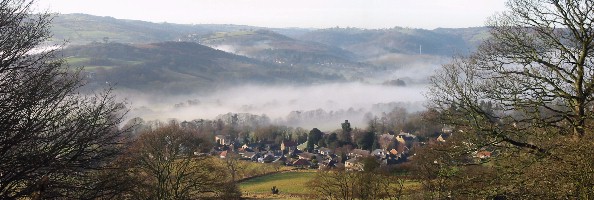
|

|
|
News
Order a Brochure
New Activity
Free Guided Walks in the Peak
District
Accommodation
New Attraction
Lea Nr Matlock Bath
Residential Art Courses in Painting, Sculpture and Drawing
New Website

|
The Route - Kilometre 0 to 19Kilometre 0 (Mile 0) BakewellThe route commences from the large car park (SK 223 685) on the east (Sheffield and Chesterfield) side of the River Wye at Bakewell. This car park is an overflow car park and has the advantage that sometimes there are no charges. See the Bakewell page for more information. Drive across the River Wye into the centre of Bakewell. In the centre, the A619 meets the A6 at a roundabout. At this roundabout turn left to take the A6 (south) towards Matlock and Derby. Meandering on the left is the River Wye. The river flows towards Rowsley at which point it combines with the River Derwent. We will see more of the River Wye at the end of route. Kilometre 3 (Mile 2) Haddon HallHaddon Hall is on the left hand side of the road. However the Hall's car park, which is very well signposted at 300 yards and 150 yards, is on the right hand side of the road. The entrance to the car park is just after its exit. So, while you are playing 'chicken' to get across this busy road, remember that you are here for enjoyment. The other cars whizzing past probably did this attraction yesterday and are trying to pick up this route at the point they left off. Continue south along the A6 towards Matlock. At 4.7 kilometres (2.9 miles) on the left can be seen an embankment and a small cutting which used to take the railway between Matlock and Buxton. Most of this line is disused, but Peak Rail are attempting to reopen the route and currently have small lengths of track at both Matlock and Buxton. There are several disused railway lines in the Peak District and we will pass over most of them. Kilometre 5 (Mile 3) RowsleyRowsley is entered at 5.1 kilometres (3.2 miles). If the route was started in the morning, with both Bakewell and Haddon having been 'done', then it is probably lunch time. There are two main feeding and watering holes within 400 metres. The first is Caudwell's Mill on the right. This is a working flour mill that also has craft workshops and a country parlour café. Car parking is just after the mill, again on the right. Both the mill and car park are well signposted. The other watering hole, The Grouse and Claret, is a few metres further on the left.
At Rowsley, as we go over the River Derwent, we join the Derwent Valley Heritage Way - a 88 kilometre (55 mile) way-marked trail through the Derwent Valley from Ladybower Reservoir in the north to the confluence of the River Derwent and River Trent in the south near Long Eaton in Nottinghamshire. Well dressings for Rowsley's 3 wells are held in the last weekend in June. Continue along the A6, which turns right, towards Matlock and Derby. In 3.5 Kilometres (2.3 miles) turn right onto the B5057, signposted to Winster. There are some smaller signs at this junction to Darley Bridge, Wensley, and Peak Rail. 400 metres down the road, there is a station on the right, by the level crossing. Kilometre 10 (Mile 6) Two Dales Peak Rail was founded in 1976 with the ambitious goal of reopening the line from Buxton to Matlock. It is a 20 mile long route and will become the longest resurrected stretch of railway in Britain. The Station building is interesting as it is neo-Georgian and quite dissimilar to the usual architectural style used by the Midland Railway company. On the left, before the level crossing, is the Station Master's house. Sir Joseph Paxton designed this building (he also designed Crystal Palace). Although looking new, it was built in 1849 and is now a listed building. Note how the windows on the ground floor are of a complementary style to those on the floor above. 150 metres after the level crossing turn left at the cross-roads. It is signposted to the Carriage Museum ½ mile. The road rises to go over the railway line. 200 metres further on the right is the Red House Carriage Museum. Continuing along the road, it rejoins the A6 in 200 metres.
 A view over the valley between Two Dales and Matlock taken at 12:30 on the 23rd December 2007 looking west. The A6 and the River Derwent are in the valley. Two Dales is to the right and Matlock is to the left. At the A6, turn right and continue towards Matlock. Kilometre 13 (Mile 8) MatlockAt the roundabout turn right, towards Derby, on the A6 and over the River Derwent. Immediately after the bridge over the River Derwent, as the A6 turns left, there is a large car park on the right by the railway station. Leave Matlock, and continue heading south towards Derby and Matlock Bath, on the A6. 800 metres (0.5 miles) after the station car park is a car park on the left. This does not get as crowded as the Matlock Bath car parks and should be considered on busy weekends. Matlock Bath is a 1.3 kilometre (0.8 mile) easy walk away. Kilometre 16 (Mile 10) Matlock Bath Parking during summer weekends can sometimes be difficult, even though there is a large car park by the station and many medium sized car parks along the A6. It is best to arrive before midday if parking is required in Matlock Bath on sunny weekends. There is always something to do in Matlock Bath. Even in winter there is the annual Boxing Day Raft Race along the River Derwent! Whereas Matlock (the town) is fairly open, Matlock Bath resides in a gorge. The section on Matlock Bath has a more detailed description of some of the attractions here. See our review of The Temple Hotel at Matlock Bath. Continue south along the A6, with the River Derwent on the left. As we leave Matlock Bath, the New Bath Hotel is passed on the right. 1 kilometre (0.6 miles) further on note the large reddish building on the left with the word Masson on it. This is one of the cotton mills built by Sir Richard Arkwright in 1783. The sign on the building implies that it was built in 1769, but this was when Arkwright's company was first established. Arkwright did not move to this area until 1771 (see the Cromford Page). The building is now a museum of textiles. This is the start of the Derwent Valley Mills World Heritage Site that stretches all the way along the Derwent Valley to Derby. The next two road signs are a green one showing Derby straight on and Newhaven and Wirksworth to the right, followed by a white sign, for Whatstandwell, Cromford Village, and Boswell straight on. Ignore them. These are followed by a Pelican Crossing. Turn left just after the Pelican Crossing, signposted to Lea, Holloway, Crich Station, Parish Church, Arkwright's Mill, Cromford Canal, High Peak Junction, and Tramway Museum. 200 metres later, go under the green low bridge (14'10"). Continue along the road as it bends to the left, and after the de-restriction sign there is Arkwright's Mill car park on the left, and 50 metres further on is the Cromford Canal car park, with public conveniences, on the right. Kilometre 18 (Mile 11) Cromford CanalPrices for this car park (known as the Cromford Wharf) are; up to 1 hour 20p; up to 2 hours 40p; up to 3 hours 80p; all day £1.50. Leave the car park and turn right. After a road junction 200 metres on the left, there is a large house on the left which was known as Cromford Bridge House where Florence Nightingale nursed her Great Aunt in 1852. Florence's mother suggested that house would make a suitable nursing home for The Sisters of Charity. In this way she hoped to satisfy what she saw as Florence's unladylike obsession with nursing in a genteel and unobtrusive manner but Florence declined. 300 metres later go under the railway bridge by Cromford Station. After the bridge, there are good views of the River Derwent to the right. 1.8 kilometres (1.1 miles) later there is the High Park Junction car park on the right. This is by the High Peak Junction and gives the shortest access to the High Peak Trail and the Leawood Pumping Station. Next Section |
Popular Derbyshire Guide Pages
JavaScript is required view this information and it would appear that your browser does not have JavaScript or JavaScript has been disabled.
Legal
This information is provided to the best of our knowledge.
We have collected and collated it in good faith but we are not responsible for its accuracy
and anyone intending to make use of this information is advised to check it out.
Well that's the legal stuff sorted. Should you decline to comply with this warning, a leather winged demon of the night will soar from the deep malevolent caverns of the white peak into the shadowy moonlit sky and, with a thirst for blood on its salivating fangs, search the very threads of time for the throbbing of your heartbeat. Just thought you'd want to know that. |
||